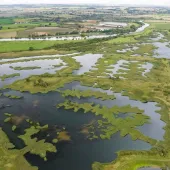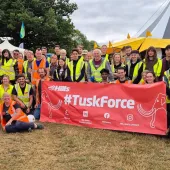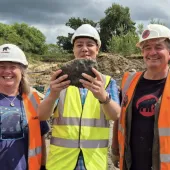Archaeological Discoveries at Summerleaze's Berry Hill Farm Quarry

First published in the May 2020 issue of Quarry Management as Unearthing the Past
Archaeologists shed light on Late Iron Age–Early Roman life ahead of final phase of mineral extraction at Summerleaze’s Berry Hill Farm Quarry
In 2017, as part of preparations for the final mineral extraction phase at Summerleaze Ltd’s Berry Hill Farm site, near Taplow, Buckinghamshire, Wessex Archaeology were commissioned to undertake a strip, map and sample excavation of 3.8ha of the land in question, referred to as Phase 4 Area 2. The excavation marked the final stage of a programme of works that had included several previous phases of excavation (totalling an additional 4.7ha) and watching brief, as well as non-intrusive surveys and assessments, undertaken since 2004, in accordance with a planning condition for permitted minerals extraction. The recent investigations uncovered a Late Iron Age–Early Roman settlement consisting of several roundhouses and other enclosures, as well as a skeleton believed to have been buried almost 2,000 years ago. The following article presents a brief summary of Wessex Archaeology’s discoveries.
The Berry Hill Farm site itself lies on a gentle south-west facing slope approximately 700m to the south-east of the centre of Taplow and 0.5km to the east of the river Thames. The various excavations at the site have produced evidence of human activity ranging from the Middle Palaeolithic (150,000–30,000 BC) to the post-medieval/modern period (16th century onwards), although the site was not continuously occupied for all this extensive time range. The focus of activity and settlement dates from the Early Neolithic to the Early/Middle Saxon periods, though it was in the later prehistoric period that the landscape was first organized, then subsequently reorganized (at least twice) in the Middle/Late Iron Age–Romano-British period, mostly for agricultural purposes, although settlement and funerary evidence are also present.
Early prehistoric evidence is restricted to the finding of an unstratified hand-axe of Middle Palaeolithic date and limited evidence of pit digging in the Early Neolithic period. A segmented ring ditch and a continuous ring ditch in the north and north-east of the site and a penannular ditched enclosure in the south-east may represent funerary monuments of possible Late Neolithic to Middle Bronze Age date, although there is no surviving evidence of associated mortuary deposits and recovered finds and environmental remains are limited in both number and range.
It was during the later prehistoric period that the landscape was first divided into a series of rectilinear fields and although dating evidence is slight (and at times mixed because of later activity relating to landscape reorganization), the origins of this belong to the Middle/Late Bronze Age, though parts may have remained in use into the Iron Age. A small number of pits and postholes and at least two waterholes appear to be associated with this field system, although no Bronze Age/Early Iron Age structures are discernible.
A Middle/Late Iron Age unenclosed settlement was revealed, represented by at least two roundhouses and a large number of pits and postholes, as well as a considerable quantity and range of both artefacts and charred plant remains. A single inhumation burial was recorded in a pit/grave, associated with structured deposits of animal bone and other finds.
In the Late Iron Age, or possibly slightly earlier, the landscape (in the southern half of the site) was reorganized into a system of sub-rectangular enclosures. The presence of these was first indicated by cropmarks on aerial photographs, as recorded in the Buckinghamshire Historic Environment Record, and confirmed by geophysical survey undertaken as part of this project. Excavation has shown that these enclosures were remodelled again in the early Romano-British period but infilled by the mid-2nd century AD. The faunal remains, and the funnel-like arrangement of ditches are likely to represent droveways, suggesting that livestock (probably cattle) may have been an important part of the economy during this period.
Other recovered artefacts and environmental remains provide some information about other domestic activities, including textile production, crop/plant processing, butchery, leather- and bone-working, and metal-working (although the evidence for these activities is in some cases slight), as well as personal dress and diet. Small groups of postholes within some of the enclosures suggest four-post structures that may have functioned as possible granaries, and a number of pits were also present.
A more extensive field system created in the Early–Middle Romano-British period replaced the earlier enclosures. A corn-drying oven and the remains of a possible structure post-date some of these field ditches, with other ditches suggesting this system too was slightly modified throughout its use. It is likely that the focus of settlement in this period lay outside the site, with the uncovered features largely representing agricultural activity on the edge of a farmstead. However, some evidence of cremation funerary rites is also recorded, including a relatively rare possible bustum burial (where the remains of the body were left undisturbed in the ashes of the funeral pyre), although there is the possibility that this relates to the Late Iron Age–Early Romano-British phase.
There appears to be a hiatus of activity within the site in the Late Romano-British period. Diagnostic Late Roman pottery is very sparse and largely came from a small number of pits and ditches; three 4th-century AD coins were also recovered.
The discovery of five sunken-featured buildings of Early/Middle Saxon date in the south of the site is regionally significant given the proximity to the rich ‘Taplow’ burial of 7th-century AD date approximately 600m to the north west and the limited evidence of contemporaneous settlement in the local area. Recovered finds and environmental remains indicate domestic activities taking place including plant processing, butchery, antler-working and textile production.
No features of medieval date were present, with only very small quantities of pottery and ceramic building material found, these probably representing the manuring of fields surrounding the village of Taplow that grew from early medieval times. A small number of field ditches in the central and eastern parts of the site are of post-medieval date, again with only a limited number and range of finds recovered. A number of pits, including some large probable quarry pits, remain undated.
The surviving multi-period remains situated on the Taplow terrace on the edge of the Thames floodplain are, overall, of local to regional significance. Further analyses focused on the stratigraphic sequence, the finds and environmental evidence, supplemented by attempts to better date this sequence through radiocarbon dating, are appropriate and will augment the current understanding of this part of the Middle Thames Valley. A programme of post-excavation analysis, guided by revised research objectives, is proposed and will lead to publication of the results in the form of a Wessex Archaeology occasional paper – a well-established series subject to academic peer review. Following the completion of the analyses, the full physical archive from the project will be deposited with Buckinghamshire County Museum and the digital archive will be deposited with the Archaeology Data Service (ADS) to ensure its long-term curation.
Acknowledgements
Wessex Archaeology extend their thanks to Summerleaze Ltd for commissioning the archaeological excavations, in particular to Mike Lowe for his communication and assistance throughout the project. The editor would also like to thank Mr Lowe for permission to publish this article.
- Subscribe to Quarry Management, the monthly journal for the mineral products industry, to read articles before they appear on Agg-Net.com








